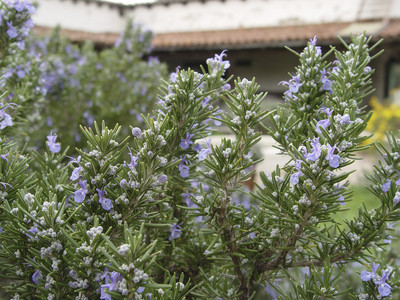Useful ornamentals

We are creatures of preconceived ideas. One of the most common is that food gardens must be separate areas of tidy rows and conventional crops. Sadly, that image doesn’t fit into many urban backyards where space is limited. Such preconceived ideas discourage the spatially challenged from believing they can grow their own food.
When it comes to gardening, you are only limited by your imagination. For most homeowners or renters, the challenge is to grow food without sacrificing landscaping.
The solution is to choose useful ornamentals over decorative plants. These plants are not only beautiful, but offer other byproducts, too. A landscape carefully filled with such plants can be highly productive, saving money without dedicating a specific area for growing food.
A good example of this mind-set is rosemary. In the Western states, this culinary herb is a beautiful drought-resistant shrub that makes a lovely small hedge or groundcover. It offers delightful blue flowers in the spring that draw bees with nectar. The foliage is legendary, used in many kitchen recipes, but it can also be steeped into a potent tea for a brown hair rinse. The variety “Barbecue” will grow with straight stems that can be cut green, stripped of their leaves and used as kebob sticks to impart its flavor to meat or vegetables.
Consider replacing what you have with useful ornamentals. Naturally, the fruit tree is our first choice because a fruiting cherry is just as beautiful as a fruitless flowering cherry. But there are other options that can provide you with craft supplies, and food.
Edible flowers. Certain bedding plants sold in six-packs at the garden center have edible petals, which are all the rage for haute fresh cuisine. Why plant your beds with inedible petunias or zinnias when you can enjoy an endless supply of petals for salads and colorful garnishes? Great starters are violas, calendula or pot marigold and nasturtium.
Productive trees. Trees not only produce fruit, but also offer beautiful decorating materials. A pomegranate offers healthy juice, but the red fruits themselves are popular dried for décor. A corkscrew willow will give you an endless supply of exotic twisted twigs as well as summer shade.
Hedge shrubs. These can do more than screen and separate. A natural hedge of blueberries allows you to grow many different varieties for an annual feast of otherwise expensive fruit. Other useful hedge shrubs include elderberry, currant and pineapple guava. In the North, a hedge of pussy willow gives an annual crop of beautiful rods for home and as gifts.
Roses. Modern carefree roses have lost their fragrance and fruit, which in the past was a vital commodity. Select roses, such as the Rugosa clan, produce vitamin-rich fruits the size of shooter marbles. The heavy fragrance of old-species roses can add to homemade sachets and potpourri.
Fruit of the vines. Choose table- or wine-grape vines in lieu of foliage or flowering vines. Not only do they offer delicious fruit, but the leaves are an ingredient for wrapping dolmas, a delicious Greek dish.
The ideas for a landscape full of useful and beautiful plants are endless.
Maureen Gilmer is a horticulturist and blogger at www.MoPlants.com/blog.












